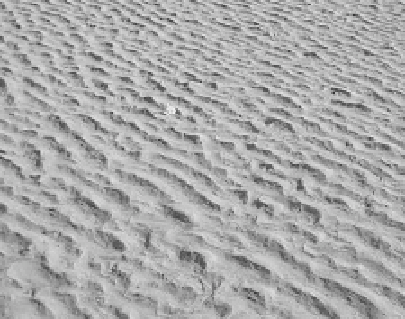Environmental Engineering Reference
In-Depth Information
parallel to each other, or have a shape like fish scales. With an increase of the flow velocity, the plan
form of the ripples gradually develops from straight lines to curves and then to a pattern like fish scales,
symmetrical or unsymmetrical. Figure 5.9(a) shows the parallel ripples and Fig. 5.9(b) shows the fish
scales ripples in the Liuhe River, which is a tributary of the Liaohe River in China. The sand diameter is
about 0.5 mm and the ripples are about 1- 4 cm high and 10 - 40 cm long.
Fig. 5.8
Development of the bed forms following increase in flow intensity (after Chien et al., 1998)
(a) (b)
Fig. 5.9
(a) Parallel ripples about 1-2 cm high and 10-20 cm long; (b) Fish scales ripples about 2-4 cm high and
20-40 cm long, in the Liuhe River which is a tributary of the Liaohe River in northeastern China
With increasing flow velocity, ripples develop further and eventually become dunes (Fig. 5.8(c)). The
size of a dune is closely related to the water depth. Figure 5.10 shows that the heights and lengths of dunes
vary significantly in different rivers. Dunes in large rivers can be kilometers long and several meters high,
such as in the Mississippi River and the Yangtze River. They may be less than half a meter in other rivers,
like the Volga River. The dunes move at different speeds, varying from 1 m/day (Volga River) to 100
m/day (the Yellow River).
Figure 5.11 shows the sand dunes on the bed of the Songzi River, which is a distributary of the middle
reaches of the Yangtze River and diverts flood water from the Yangtze River into Tongting Lake. The bed
material consists of fine sand with diameter around 0.1 mm. The sediment is rather uniform. The dunes
are 0.5-1 m high and 10-30 m long. Compared with ripples sand dunes are rather irregular in shape.




Search WWH ::

Custom Search